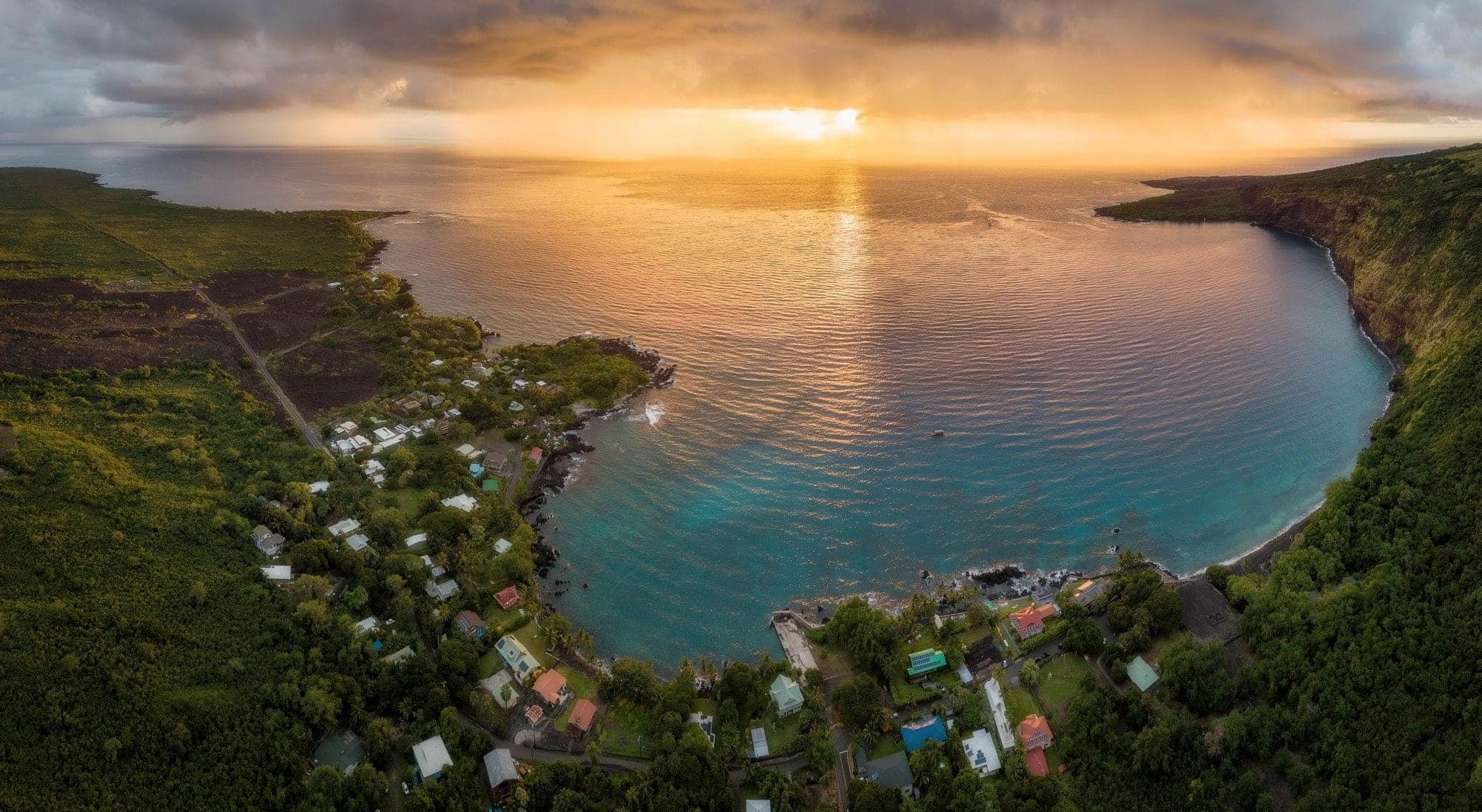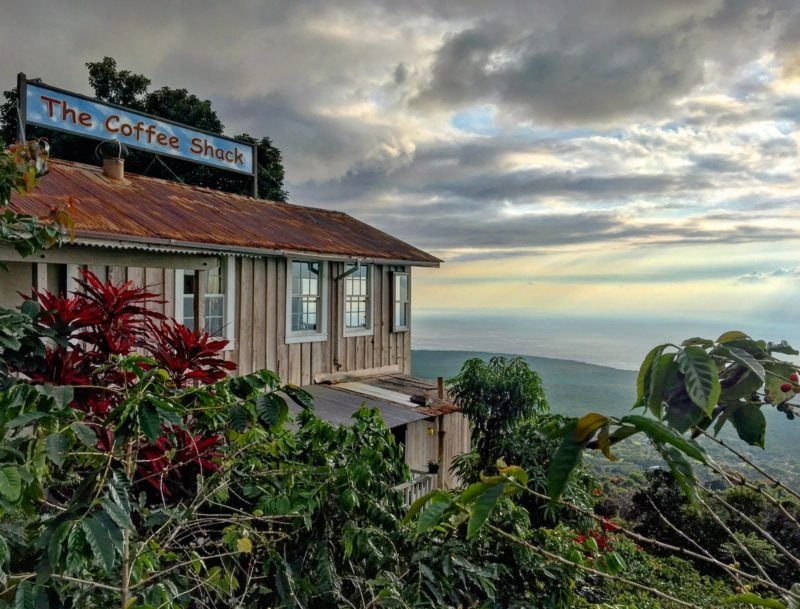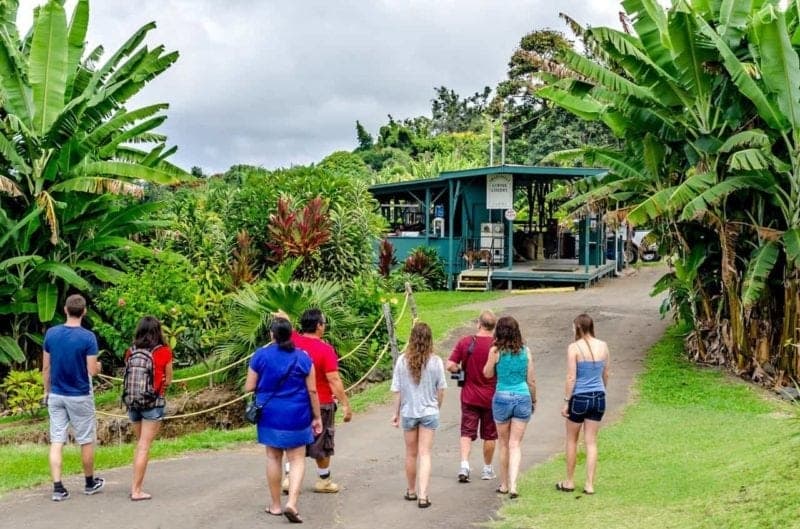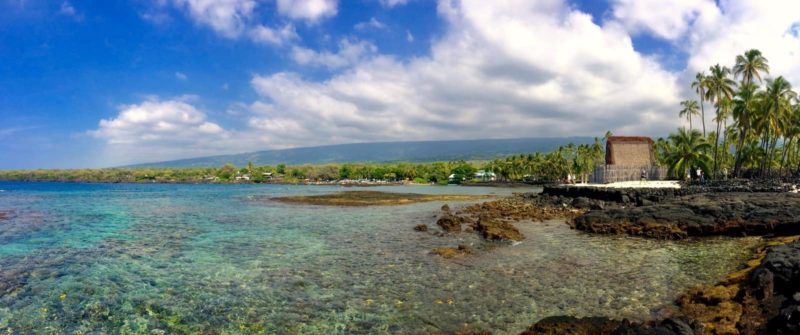Located on the lush and tropical South Kona coast, Kealakekua Bay is home to a spectacular coral reef. The bay is home to one of the best snorkeling spots in the entire state of Hawai’i and the nearby lush and tropical region (the Kona coffee coast) is also a place of great historical significance, as it holds many archeological and historical sites. This region is definitely worth a visit!
In this guide we explain how to get there, what to see and do, and more. Use the Table of Contents to jump ahead to the topic of your interest:
Table of contents
An in-depth description of the (pre-contact) cultural history of Kealakekua Bay is not within the scope of our visitor guide, but if you are interesting in brushing up your your knowledge, you should definitely have a look at this 1992 resource study on historical sites on Hawai’i island.
Kealakekua Bay (about)
Kealakekua Bay is a piece of paradise, both on land and under water. The bay hosts one of the most abundant coral reefs on the island and is located on the lush and tropical Kona coast. The center of the bay is deep and you can often find a pod of spinner dolphins that use the bay as resting grounds (read more on how to behave around wild dolphins).
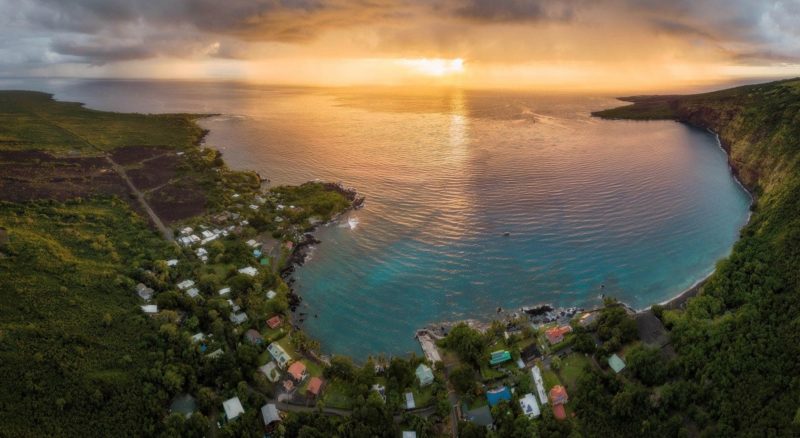
Kealakekua Bay is one of the jewels of the south Kona district. You can find world-class snorkeling waters in a tropical bay smack in the middle of the lush Kona Coffee district. Image source: @TioLuz on instagram
The whole region is rich in history and spans both a marine life conservation district *and* a state historical park. You can read more about both below:
Kealakekua Bay is a Marine Life Conservation District
There are 11 Marine Life Conservation Districts (MLCDs) in the state of Hawai’i (5 of which are on the Big Island), and the 315 acre Kealakekua Bay MLCD is the largest of them all.
A MLCD is a part of the ocean with an especially abundant reef habitat, where the fish population is given special protection against human interference. This protection means that fishing and other consumptive uses are prohibited or severely limited so that all aquatic live can grow and reproduce. MLCDs are thus home to a great variety of species, and the fish in these districts are fairly tame, often showing little fear of humans. This explains why an MLCD is such a popular destination for snorkeling, diving and underwater photography.
If you are interested in learning more about our MLCDs you can do so on the official DNLR website.
Kealakekua Bay State Historical Park (and Napoʻopoʻo Beach Park)
The Kealakekua Bay State Historical Park spans the shoreline of almost all of Kealakekua Bay (except the south-eastern shoreline). The most accessible part of it is on the north-eastern edge of the bay where you can find Nopoʻopoʻo Beach Park with a parking area, a picnic pavilion, restrooms, showers, and a water fountain.
The small beach in the park next to the pavilion is known as “Napoʻopoʻo Beach” and was stripped of its sand by hurricane Iniki back in ’92. It now consists of a collection of rocks and, while not great for hanging out, it is reasonable for a quick swim and a good place for snorkeling. Note that there is no lifeguard on duty.
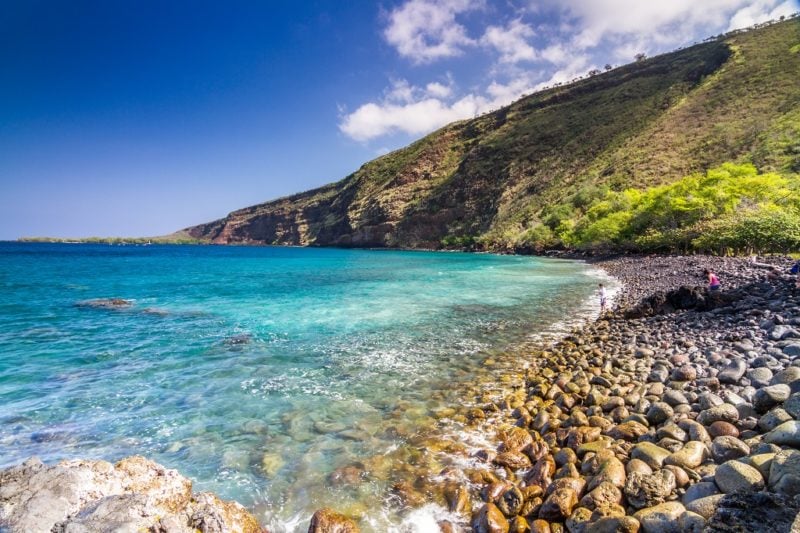
Napo’opo’o Beach is a small rocky beach in the Kealakekua Bay State Historical Park. Image credit: Nnachappa64 – Own work, CC BY-SA 4.0, Link
You can also find the Hikiau Heiau in this park. This Heiau is a well-preserved ancient temple in the park dedicated to the Hawaiian god Lono, but with a dark history: it was built as a place of human sacrifice.
Read more about the state park on the official state park website.
The Captain Cook Monument
Today the waters of Kealakekua Bay are quiet and serene, but things were not always like this!
Kealakekua Bay is an important historic location because it is where Captain James Cook landed for the first time on the island of Hawaii. One year later, on February 14, 1779, the same James Cook was killed here during his 3rd visit to the Hawaiian islands. This happened in a conflict that could probably have easily been avoided with more knowledge of the Hawaiian culture. You can find a well-written account of these faithful events in an article on the Coffeetimes website called “the demise of Captain Cook“.
Nowadays this well-known explorer is remembered through one of the major landmarks on the south Kona coast: the 27 ft. tall Captain Cook monument. This structure was built in 1878 and is a white obelisk located at the Ka’awaloa Flats, in the western portion of the Kealakekua Bay State Historical Park.
You cannot reach the monument by car but it is possible to either hike to the monument or to get there over water (either by kayak or with a snorkeling tour).
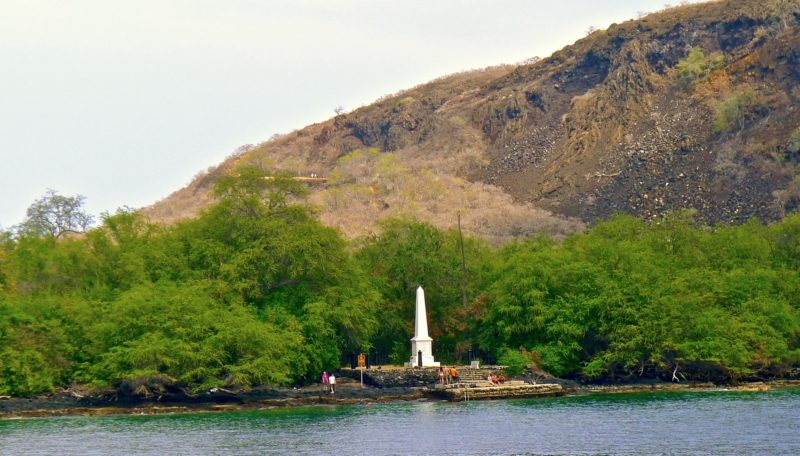
The Captain Cook Monument is a 27 ft. tall white obelisk commemorating the explorer on the western shore of Kealakekua Bay
Things to do in Kealakekua Bay (water related activities):
The main things to do here are all water-related. The bay’s transparent waters are filled with coral, and schools of colorful tropical fish. Spinner dolphins sightings are common as they use the bay as a resting area.
The following activities will give you a chance to explore the pristine waters of Kealakekua Bay:
- Snorkeling
- Hiking
- Kayaking
- Boat tours
- Scuba diving
- Important note on how to behave around the wild dolphins
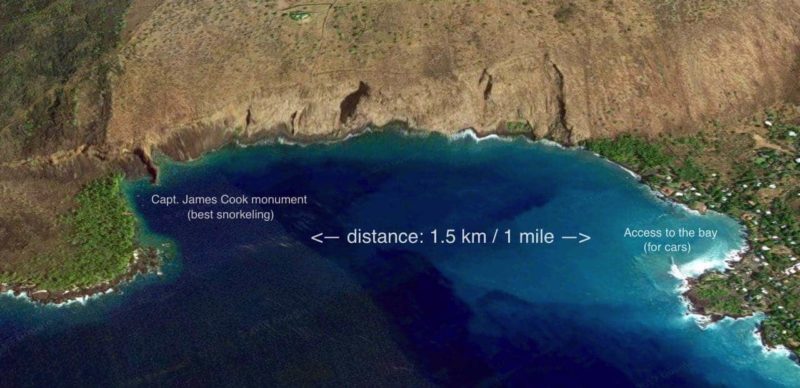
Kealakekua bay is a 1-mile wide bay close to the town of Captain Cook on the Big Island. The best snorkeling is on the northern (left on the picture) side of the bay. Image credit: google maps
1: Snorkeling in Kealakekua Bay
Kealakekua Bay is one of the best places in the entire state for snorkeling. Fish are plentiful, colorful and swarm over a well-developed reef that slopes steeply from the shore into the nearby deep water, making it easy to see different kinds of reef in a relatively short time.
The Nāpō‘opo‘o area (at the dock, where you’ll most likely park your car) is generally shallow with little coral, but snorkeling gets better going south a few 100 feet (meters) toward the southern tip of Manini Beach Point. Encrusting coral, caves, crevices and ledges, all can be found in these waters down to about 30 feet deep.
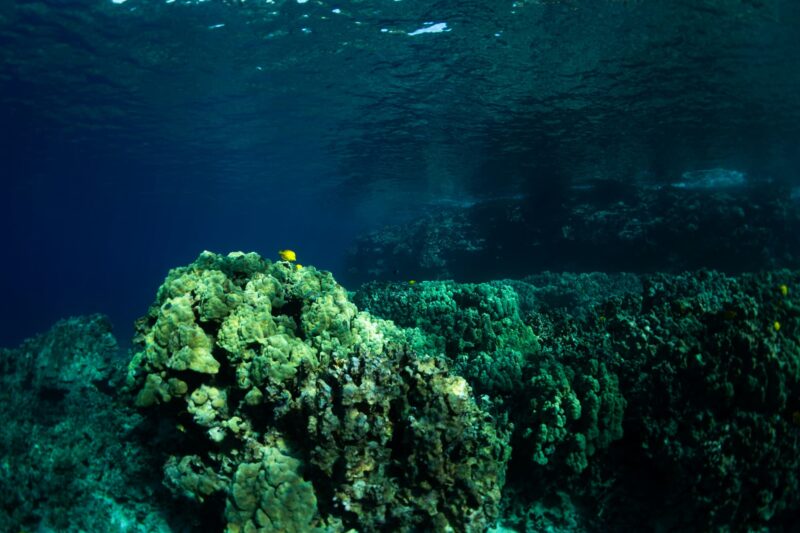
One of the many Pristine coral formations within Kealakekua Bay on the Big Island of Hawaii. Photo by Sarah Lee on Unsplash
Going north from the Nāpō‘opo‘o area (the bay’s northeastern side), the waters below the pali (cliff) are good for snorkeling during calm water conditions. Abundant coral growth and marine life can be seen in waters of about 5 feet deep.
The best snorkeling spot, however, is on the opposite side of the bay from the parking area, in front of the Ka’awaloa Flats (where the Captain Cook monument is located). There is no parking anywhere near the best snorkeling waters though, so you have to jump through some proverbial hoops to get to where you want to be.
There are 3 ways to get close to this best snorkeling area:
2: Hiking to the Captain Cook Monument (3.8 miles round trip)
The hike down into Kealakekua bay to the Capt. Cook monument is challenging and not particularly scenic. The main reason people make this hike is to reach the Ka’awaloa Flats area without having to pay for renting a kayak a boat tour.
From the trailhead you need to hike 1.9 miles to the water entry point, and over that distance you’ll lose 1300 ft. (400 meters) in elevation. After you are done snorkeling you have to make up for that elevation again. To make matters more interesting: almost all of the trail is exposed to full sun. Bring a hat, sunscreen, plenty of water, comfortable and close-toed shoes, and, of course, snorkeling gear!
If you are interested in making the hike you should have a look at the great description on the BigIslandHikes website for further planning.
3: Kayak rentals
Kayaking from the boat landing to the statue takes between 15 and 25 minutes (one way). Bring plenty of water, sunscreen, and again, don’t forget your snorkeling gear!
Note that you are not allowed to land your kayak at the Ka’awaloa Flats (the piece of land on which the Captain Cook monument is located), which effectively means you’d have to tie off your kayaks together while they float in the water and keep an eye on them while you are snorkeling.
Kayaking permits:
The local ecosystem in Kealakekua Bay is suffering under its own popularity, and the Division of State Parks now issues mandatory permits for people seeking to take a vessel on the waters of the bay to prevent further damage to the shoreline and coral reef. While it is possible to obtain your own permit, it is a non-trivial process that takes a few weeks to complete (contact the State Parks office in Hilo at (808) 961-9540 for more information).
Luckily there are other options. You are not required to get your own permit when renting a kayak if the vessel possesses a valid permit for transiting the bay. This can be done either by joining a guided Kayak tour or by renting a kayak yourself.
Guided kayak tours:
Only three companies have been issued permits by the Division of State Parks to lead guided commercial kayak tours to the Captain Cook Monument (last verified November 2022, source). These are:
- Adventures in Paradise (approx $100/3.5 hours, use discount code “save10” to save $10 when booking at least five days in advance),
- Aloha Kayak Co (approx $100/3.5 hours)
- Kona Boys, Inc (approx $200/4.5 hours)
Morning and Noon Kayak & Snorkel at Kealakekua Bay
No experience necessary, beginners and children welcome. Join us as we guide you to Kealakekua Bay, then snorkel Captain Cook Monument!
from:
$119.95
What is a suggested tour?Our suggested tours are hand-picked tours that receive consistent good reviews, give back to the community, and work hard to minimize their impact on the environment. Read more about these tours on our website.Renting a kayak yourself:
If you want to make the trip yourself you can find people offering kayak rentals on the side of Hwy 11 and along the road down to the bay (route 160). The list of permitted vendors changes often so please make sure to ask whomever you choose if they have a current commercial use permit. As of June 2019 it is mandatory for the permitted vessels to have the State Parks issued decals affixed to both sides of kayak bows so please also check for that to ensure that you support only permitted businesses.
4: Boat tours to Kealakekua Bay (snorkeling & scuba diving)
The easiest way to visit Kealakekua Bay for snorkeling or diving is as part of one of the many snorkel tours to the Captain Cook Monument.
Tour operators are familiar with the best areas in the bay to see fish and corals, and some companies also include lunch in the price of the tour. The cruises generally take between 3 hours and half a day and provide snorkeling gear, snacks and refreshments, as well as cultural, natural and historical information relevant to Kealakekua bay.
Tours operators that follow the Sustainable Tourism Association of Hawai’i (more info) guidelines are e.g. Sea Paradise and Fair-Wind (both departing from Keauhou Bay). Body Glove cruises (departing from Kailua-Kona) organizes dinner cruises to the bay without the possibility of snorkeling.
Afternoon Sail & Snorkel Tour to Kealakekua Bay
Sail to one of the best snorkeling spots on the island past the scenic Kona coastline with a spacious 50 foot catamaran from Keauhou to Kealakekua Bay. Notoriously difficult to reach over land, this is one of the best snorkeling spots on the island with pristine clear blue waters and a vibrant reef.
from:
$125
What is a suggested tour?Our suggested tours are hand-picked tours that receive consistent good reviews, give back to the community, and work hard to minimize their impact on the environment. Read more about these tours on our website.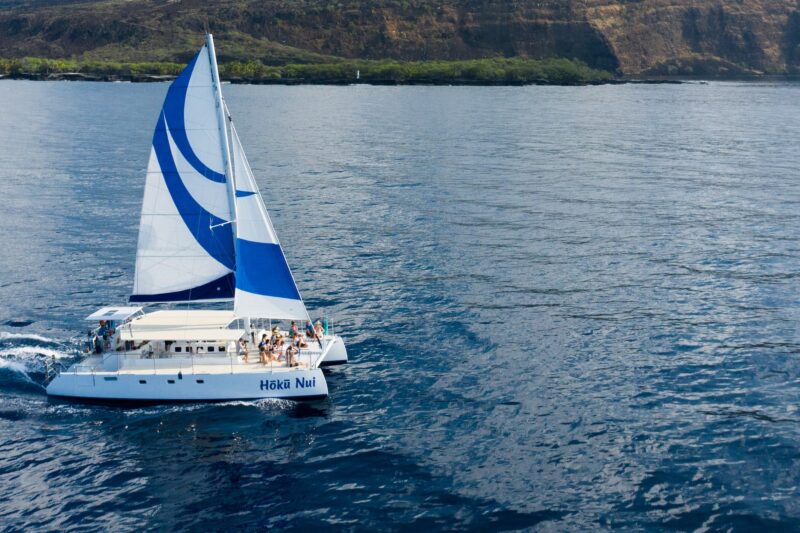
Boat tours are the easiest way to go snorkeling at Kealakekua bay. This is the Hoku Nui catamaran from Sea Paradise in front of Kealakekua Bay, read more about snorkeling tours to Kealakekua Bay by Sea Paradise.
5: Scuba diving
Clear waters and abundant wildlife make Kealakekua bay a great place to go diving. The waters between the Nāpō‘opo‘o landing and the southern tip of Manini Beach Point (the eastern side of the bay) are an interesting place to dive, and you can find encrusting coral, caves, crevices and ledges down to about 30 feet deep. Waters here can get rough with high surf though, and you should only enter the waters here when the ocean conditions are calm.
The bay’s best diving however is on the (more protected) other side of the bay, in Ka‘awaloa Cove (near the monument). Water depths here range from about 5 to 120 feet and the diversity of coral and fish is exceptional.
You can either bring your own gear or to join a diving tour that handles all logistics for you, see our scuba diving guide for more information.
6: Important: how to behave around the wild dolphins
Dolphins are very smart and playful mammals and it can seem like great fun for both parties to play with dolphins. However, seeking out and trying to interact with the dolphins disturbs their natural behaviors and can interrupt much-needed rest periods.
Interactions between wild animals (dolphins) and humans are almost always disadvantageous for the animals but there are ways to mitigate our impact. The most important thing you can do is respecting the resting behaviors of the spinner dolphins during their peak resting period between ~10.00 and ~14.00.
Guidelines for seeing dolphins with a boat
If you have your own boat and happen to see dolphins, please observe the following guidelines:
- Remain at least 50 yards (1/2 a football field) from spinner dolphins.
- Limit your time observing to 1/2 hour.
- Spinner dolphins should not be encircled or trapped between boats or shore.
- If approached by a spinner dolphin while boating, put the engine in neutral and allow the animal to pass. Boat movement should be from the rear of the animal.
You can find more information at the NOAA “protect dolphins campaign”. Please stay safe and treat the dolphins with aloha – observe them from a distance
Read more about seeing dolphins on our website.
How to get to Kealakekua Bay:
To get to the bay you need to get to take the Nāpō‘opo‘o turn off onto Nāpō’opo’o Road, which intersects with Highway 11 near the 111 mile marker, about 13 miles (20 km) south of Kona. The trailhead for the hike to the monument is only a few hundred feed after this intersection, while you need to follow Nāpō’opo’o Road another 4.5 miles (7 km) to its end to get to the eastern shoreline of the bay.
Ka‘awaloa Cove, the spot with the best snorkeling at the bay’s northern boundary just north of the Captain Cook monument, can be accessed only by hiking in, or over the water.
Nearby things to do (non water-related attractions)
It would be a waste of time to only visit the bay without seeing any of the other nearby attractions on the south Kona coast. This is the lush and tropical Kona Coffee country, and a great place for a road trip!
The following things are popular activities in the area:
Sunsets! (Manini beach)
Manini Beach, halfway the eastern shore of the bay, is a GREAT place to see the sun set.
The small rocky beach (no sand) is located in front of Napo’opo’o park at the end of Manini Beach Rd, 0.4 miles from the Kealakekua Bay State Park. There is a large lawn and a ‘point’ that extends into the bay from which you have a great view of the setting sun.
Parking places are sparse here, which makes finding a spot difficult, especially during the hour before sunset.
